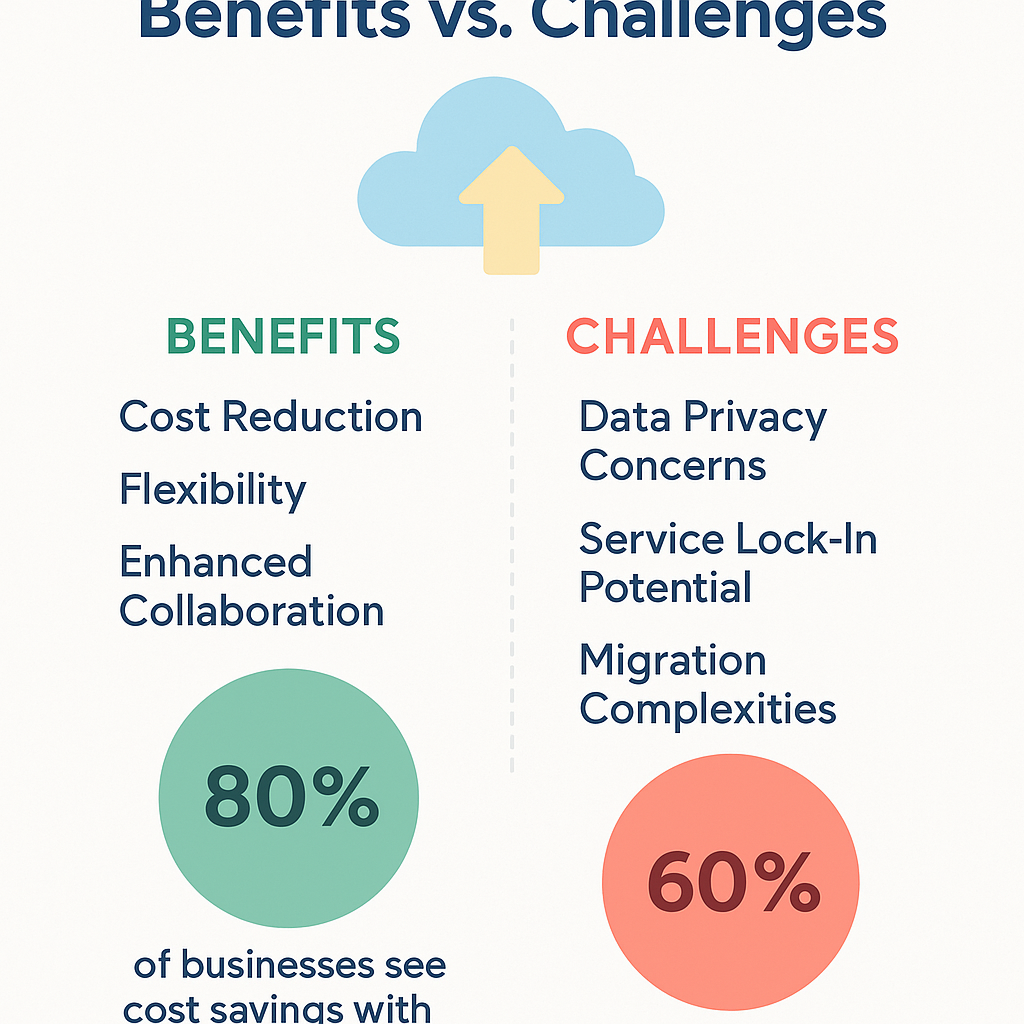Cloud computing has revolutionized how businesses access and manage technology resources through on-demand delivery over the Internet. This comprehensive overview explores the fundamental concepts, service models, and deployment strategies that define modern cloud infrastructure. Understanding these elements is crucial for organizations seeking to leverage scalable, cost-effective solutions in today’s digital landscape.
To remember
Cloud computing reduces IT infrastructure costs by up to 30% while providing instant scalability and global accessibility. The three primary service models – IaaS, PaaS, and SaaS – each serve distinct business needs, from basic infrastructure provisioning to complete software solutions, enabling organizations to optimize resources and accelerate digital transformation initiatives.
Understanding cloud computing
Cloud computing represents a fundamental shift in how organizations access and utilize technology resources. Rather than maintaining physical servers and data centers on-site, businesses can now leverage remote computing infrastructure delivered through the internet on an on-demand basis.
The Foundation of Cloud Computing
At its core, cloud computing enables users to access virtualized computing resources—including processing power, storage, and networking capabilities—through internet connectivity. This model eliminates the need for substantial upfront capital investments in hardware and reduces the complexity of managing physical infrastructure. Organizations can provision resources instantly, scaling up or down based on current demands without the constraints of fixed hardware limitations.
The pay-as-you-go pricing model represents a significant departure from traditional IT procurement. Instead of purchasing expensive equipment that may remain underutilized, businesses pay only for the resources they actually consume, leading to more predictable operational expenses and improved cost efficiency.
Cloud Deployment Models
Three primary deployment models define how cloud services are delivered and accessed. Public clouds offer services to multiple customers through shared infrastructure managed by third-party providers. These environments provide maximum cost efficiency and scalability, making them ideal for businesses seeking rapid deployment and minimal administrative overhead.
Private clouds deliver dedicated resources to a single organization, either hosted on-premises or by external providers. This model offers enhanced security and control, particularly valuable for companies handling sensitive data or operating under strict regulatory requirements.
Hybrid clouds integrate both public and private environments, allowing organizations to optimize workload placement based on specific requirements. This approach enables businesses to maintain sensitive operations in private environments while leveraging public cloud resources for less critical applications, achieving both security and cost optimization.
Economic and Operational Benefits
The economic advantages of cloud computing extend beyond simple cost reduction. Organizations experience improved operational agility through rapid resource provisioning, enhanced disaster recovery capabilities, and reduced IT maintenance burdens. The ability to scale resources dynamically ensures businesses can respond quickly to market demands without overprovisioning infrastructure, ultimately supporting more efficient business operations and competitive positioning.

Exploring the primary types of cloud services
The cloud computing ecosystem offers three primary service models that cater to different business needs and technical requirements. Each model provides varying levels of control, management responsibility, and abstraction, enabling organizations to select the most appropriate solution for their specific use cases.
Infrastructure as a Service (IaaS): The Foundation Layer
IaaS provides users access to fundamental computing resources including virtual machines, storage, networks, and operating systems on a pay-as-you-go basis. This model offers the highest level of control over IT infrastructure while eliminating the need for physical hardware investment. Amazon Web Services (AWS) leads this market segment with services like EC2 for compute instances and S3 for storage. Microsoft Azure provides similar capabilities through Azure Virtual Machines and Azure Storage, while Google Cloud offers Compute Engine and Cloud Storage solutions.
Organizations benefit from IaaS through reduced capital expenditures, scalable resource allocation, and the ability to quickly provision or decommission infrastructure based on demand fluctuations.
Platform as a Service (PaaS): Development Simplified
PaaS delivers a complete development and deployment environment in the cloud, enabling developers to build, test, and deploy applications without managing underlying infrastructure. This model accelerates application development by providing pre-configured development tools, database management systems, and middleware components.
Leading providers offer comprehensive PaaS solutions: AWS provides Elastic Beanstalk and Lambda for serverless computing, Microsoft Azure offers App Service and Azure Functions, while Google Cloud delivers App Engine and Cloud Functions for application hosting and development.
Software as a Service (SaaS): Ready-to-Use Applications
SaaS represents the most abstracted cloud service model, delivering fully functional software applications over the internet on a subscription basis. Users access these applications through web browsers without installation or maintenance responsibilities. Popular examples include Microsoft Office 365, Google Workspace, and Salesforce CRM platforms, demonstrating how SaaS transforms software consumption from ownership to subscription-based access.

Cloud computing deployment and security practices
Organizations today face critical decisions when selecting cloud deployment models and implementing robust security frameworks. The choice between different deployment strategies directly impacts data protection, operational efficiency, and regulatory compliance requirements.
Understanding Cloud Deployment Models
A public cloud represents the most widely adopted deployment model, where third-party providers like AWS, Microsoft Azure, and Google Cloud Platform deliver computing resources over the internet. These services offer exceptional scalability and cost-effectiveness, as organizations only pay for consumed resources. Public cloud infrastructure enables rapid deployment and global accessibility, making it ideal for businesses seeking immediate scalability without substantial upfront investments.
Private cloud deployment provides dedicated infrastructure exclusively for a single organization. This model delivers enhanced control over data and security configurations while maintaining cloud benefits like virtualization and automated provisioning. Private clouds can be hosted on-premises or managed by third-party providers, offering organizations complete governance over their computing environment.
Hybrid cloud architecture represents a strategic combination of public and private cloud resources, enabling organizations to optimize workload placement based on specific requirements. This deployment model allows sensitive data to remain in private environments while leveraging public cloud capabilities for non-critical applications and burst capacity needs.
Essential Security Practices and Industry Standards
Cloud security implementation requires comprehensive data protection strategies encompassing multiple layers of defense. Encryption serves as a fundamental security measure, protecting data both in transit and at rest. Leading cloud service providers implement advanced encryption standards, with AWS utilizing AES-256 encryption and Google employing envelope encryption techniques across their infrastructure.
Access control mechanisms form the cornerstone of cloud security architecture. Identity and Access Management (IAM) systems enable granular permission management, ensuring users receive appropriate access levels based on their roles and responsibilities. Multi-factor authentication and role-based access controls significantly reduce unauthorized access risks.
Compliance measures align cloud deployments with industry regulations such as GDPR, HIPAA, and SOC 2 standards, ensuring organizations meet legal and regulatory requirements while maintaining operational flexibility in cloud environments.

Benefits and challenges of adopting cloud computing
Cloud computing adoption continues to reshape business operations across industries, offering compelling advantages while presenting distinct challenges that organizations must navigate strategically. Understanding this balance is crucial for making informed decisions about cloud migration and implementation.
Key Benefits Driving Cloud Adoption
The cost-effectiveness of cloud computing remains a primary driver, eliminating capital expenses for hardware and infrastructure while enabling pay-as-you-go pricing models. Organizations benefit from increased speed and agility, with most cloud computing services providing self-service provisioning that allows vast computing resources to be deployed in minutes rather than weeks.
Flexibility and scalability represent significant advantages, as cloud platforms deliver elastic scaling capabilities that adjust resources based on demand. This eliminates the need for massive investments in local infrastructure that might remain underutilized. Enhanced collaboration capabilities enable secure access to data and applications from any location with internet connectivity, facilitating remote work and global service delivery.
Persistent Challenges and Mitigation Strategies
Despite these benefits, data privacy concerns remain paramount. Organizations must entrust sensitive information to third-party providers, raising questions about unauthorized access, breaches, and compliance with regulations. Security demands careful attention to cloud configurations and business policy implementation.
Service lock-in presents another challenge, as migration between cloud providers can be complex and costly. Unpredictable costs also emerge when pay-as-you-go models create interdependent services that appear in monthly bills, making final cost prediction difficult.
To address these challenges, many organizations adopt hybrid cloud architectures, balancing on-premises infrastructure with cloud services. Advanced cost management tools like AWS Cost Explorer and frameworks such as FinOps help standardize financial operations, while proper governance and oversight minimize unused resources and hidden costs.

What to remember about cloud computing evolution
Cloud computing continues to evolve as a cornerstone of digital transformation, offering unprecedented scalability and flexibility for modern enterprises. As artificial intelligence integration and edge computing capabilities expand, organizations must adapt their cloud strategies to remain competitive. The future promises enhanced automation, improved security protocols, and seamless hybrid environments that will further democratize access to advanced computing resources.